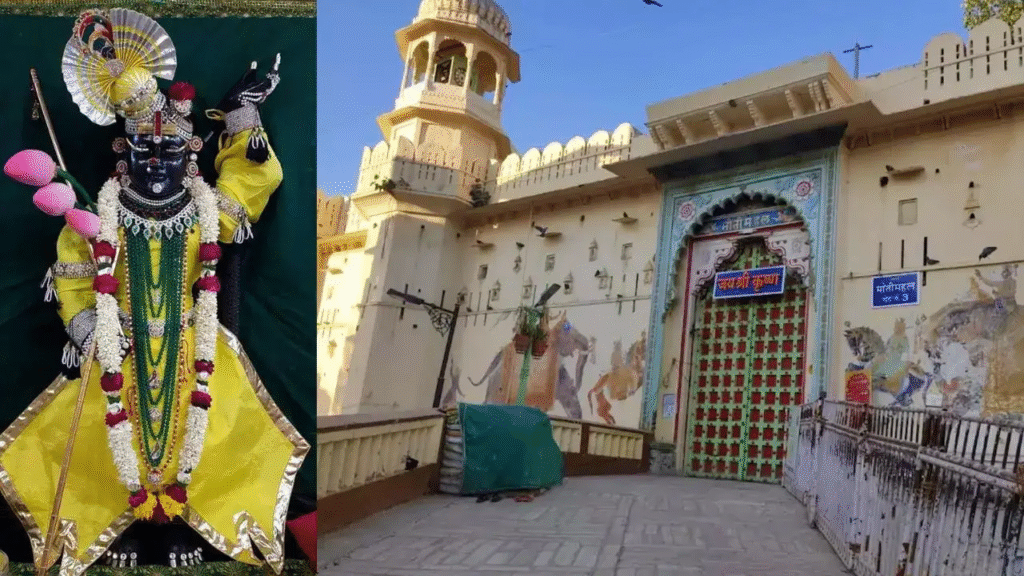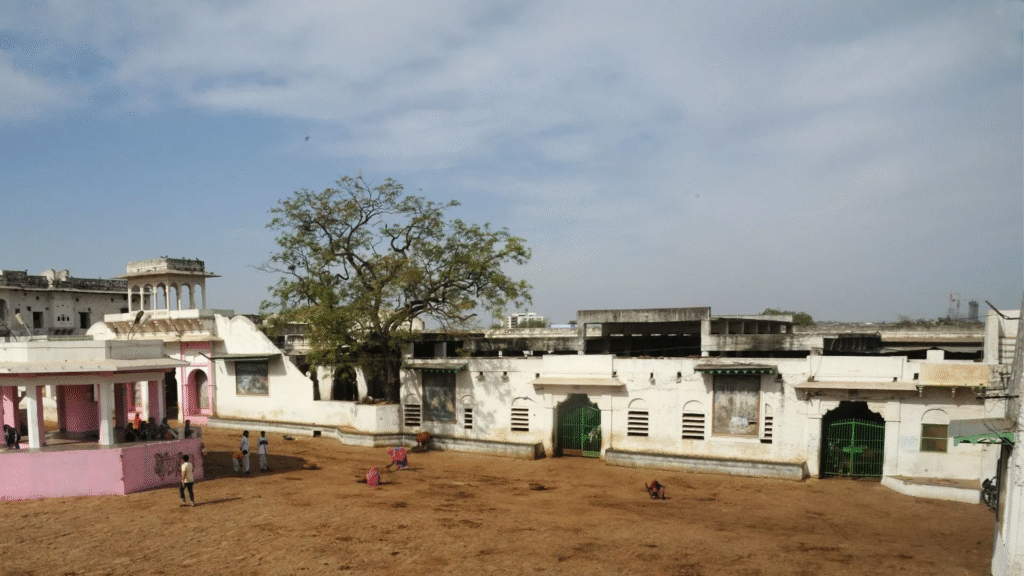History and Importance of Shrinathji Temple Nathdwara

8 Must-Visit Lakes in Udaipur for Beauty and Calm
October 17, 2025Located in the heart of Rajasthan, Shrinathji Temple in Nathdwara is not just a spiritual destination—it is a symbol of faith, devotion, and rich Vaishnavite tradition. This temple, dedicated to Lord Krishna in his child form as Shrinathji, attracts millions of devotees from across India and abroad. From its glorious history to the mesmerizing rituals and architecture, every aspect of the temple reflects divinity and cultural grandeur. For travelers planning a visit, choosing the udaipur taxi service ensures a comfortable and convenient journey to this sacred destination.
This article delves deep into the history, architecture, darshan timings, and travel tips for visiting Shrinathji Temple Nathdwara, offering an in-depth guide for devotees and travelers planning to experience the eternal charm of this holy town.

History of Shrinathji Temple
The Shrinathji Temple Nathdwara holds immense historical and religious importance, tracing its origins back to the 17th century. The presiding deity, Shrinathji, represents a seven-year-old form of Lord Krishna lifting the Govardhan Hill, symbolizing his divine protection of devotees. The idol of Shrinathji originally resided in Govardhan, near Mathura, Uttar Pradesh.
During the reign of Mughal Emperor Aurangzeb, who ordered the destruction of Hindu temples, the priests decided to move the sacred idol of Shrinathji to a safer place in Rajasthan. The journey began from Vrindavan, and when the chariot carrying the deity reached Nathdwara, the wheels got stuck in the mud and could not move further. Interpreting this as a divine sign, the priests decided to establish the temple right there, in what is now known as Nathdwara—meaning ‘Gateway to the Lord’.
The temple was built under the patronage of Maharana Raj Singh of Mewar around 1672 AD. Since then, Shrinathji Temple Nathdwara has remained the spiritual epicenter of Pushti Marg (the Path of Grace), founded by Jagadguru Vallabhacharya. His descendants continue to serve as the temple’s head priests, preserving ancient rituals and traditions that have continued for over 350 years.
Over the centuries, Shrinathji Temple became not only a religious site but also a cultural hub, inspiring art, music, and miniature paintings. Nathdwara is renowned for its Pichwai paintings, intricate artworks that depict scenes from Lord Krishna’s life, especially Shrinathji’s various forms and leelas.
Best Time to Visit Shreenathji Temple
Though devotees visit Shrinathji Temple Nathdwara throughout the year, the best time to plan your trip depends on both the weather and the temple festivals.
October to March is considered the best time to visit. The weather remains pleasant, with cool temperatures ideal for exploring the temple and nearby attractions.
Monsoon season (July–September) adds a refreshing charm to Nathdwara, with lush surroundings enhancing the divine experience.
Summer (April–June) can be quite hot, but this is also when some of the most important festivals, such as Janmashtami and Nand Mahotsav, take place, drawing thousands of devotees.
One of the most spiritually enriching experiences during your visit is the Shrinathji Mangla Darshan—the first darshan of the day, conducted early in the morning when the Lord is believed to awaken. Many devotees plan their trip specifically around the Shrinathji Mangla Darshan timings, as witnessing this ritual multiple times is considered highly auspicious. Some devotees make it a tradition to attend Shrinathji Mangla Darshan at least 10–15 times in their lifetime to seek divine blessings and peace.
Architecture of Shrinathji Temple
The architecture of Shrinathji Temple Nathdwara reflects a harmonious blend of simplicity and grandeur. The temple’s design closely resembles the house of Nanda Maharaj, Lord Krishna’s foster father in Vrindavan. Unlike other temples in Rajasthan, the focus here is on spiritual intimacy rather than opulent display.
The temple complex is built in the traditional Haveli-style architecture, resembling a mansion rather than a conventional temple. This design signifies that the deity is treated as a living entity—Shrinathji is not just worshipped but served, cared for, and adorned as a beloved child of the devotees.
Key Architectural Highlights
Main Sanctum (Garbhagriha):
The central shrine houses the idol of Shrinathji, made of black stone, depicting Krishna lifting the Govardhan Hill with his left hand. His right hand rests gracefully on his waist. The idol’s expressive eyes and divine smile captivate every devotee.
Silver Doors and Marble Courtyard:
The temple features beautifully carved silver doors and an open marble courtyard where rituals and festivals are celebrated.
Decorative Haveli Rooms:
The temple complex includes separate chambers known as Seva Kunj and Bhog Mandap, where offerings (bhog) are prepared for the deity.
Art and Frescoes:
Walls of the temple are adorned with Pichwai paintings—traditional artworks depicting scenes from Krishna’s life. These paintings are changed according to the season and festival, creating a living museum of devotional art.
The temple’s architecture and ambiance beautifully combine devotion, artistry, and heritage, making it one of the most sacred and visually appealing temples in Rajasthan.

How to Reach Shrinathji Temple?
Reaching Shrinathji Temple Nathdwara is convenient, as the town is well-connected by road and rail to major cities in Rajasthan, especially Udaipur, which is the nearest major hub.
By Road:
The distance from Udaipur to Nathdwara is approximately 45 kilometers, making it an easy and scenic drive of about 1.5 hours. Whether you choose a private taxi, cab, or bus, the route offers stunning views of the Aravalli hills. Many visitors prefer Udaipur to Shreenathji road trips, combining their temple visit with sightseeing around Udaipur and Rajsamand.
By Train:
The nearest railway station is Mavli Junction, about 30 km away. Regular trains from Udaipur, Jaipur, and Ahmedabad connect here. From Mavli, taxis and buses are readily available to Nathdwara.
By Air:
The nearest airport is Maharana Pratap Airport Udaipur, located around 60 km from Nathdwara. From the airport, you can hire a taxi or book a cab for a smooth journey to the temple town.
Thus, whether you are traveling from Udaipur to Shreenathji or from other parts of Rajasthan, the journey is comfortable and filled with scenic charm.
Darshan Timings and Entry Fees at Shreenathji Temple
The Nathdwara Shrinathji Darshan time follows a strict daily schedule known as “Ashtayam Seva,” consisting of eight daily darshans or viewing sessions. Each darshan represents a different phase in the Lord’s daily routine—from waking up in the morning to resting at night.
Below is the general Shrinathji Temple Darshan Timetable (may vary on festival days):
- Mangla Darshan: 5:30 AM to 6:30 AM
- Shringar Darshan: 7:15 AM to 7:45 AM
- Gwal Darshan: 9:15 AM to 9:45 AM
- Rajbhog Darshan: 11:15 AM to 12:00 Noon
- Utthapan Darshan: 3:30 PM to 3:45 PM
- Bhog Darshan: 4:45 PM to 5:15 PM
- Sandhya Aarti: 5:45 PM to 6:30 PM
- Shayan Darshan: 7:30 PM to 8:00 PM
Note: Darshan timings may change during special festivals or seasons. Devotees are advised to check Nathdwara Shrinathji Darshan time in advance.
There is no entry fee to visit the temple; however, donations are welcomed for temple maintenance and religious services.
Among all, the Shrinathji Mangla Darshan is considered the most auspicious. Witnessing this early morning ritual multiple times—preferably 10–15 times—is believed to bring immense blessings, prosperity, and spiritual elevation. For devotees planning to explore nearby attractions, opting for an udaipur local sightseeing tour package (2 Days) can be an excellent way to combine divine experiences with the cultural charm of Rajasthan’s City of Lakes.
Festivals in Shrinathji Temple
Festivals at Shrinathji Temple Nathdwara are celebrated with grandeur, devotion, and color. Every festival transforms the temple into a vibrant hub of music, dance, and rituals.
Major Festivals:
Janmashtami
The birth of Lord Krishna is the most important festival. The temple is beautifully decorated, and thousands gather for the midnight darshan of Shrinathji.
Annakut / Govardhan Puja
Celebrated a day after Diwali, this festival marks Shrinathji lifting the Govardhan Hill. The temple prepares and offers a mountain of food items (Annakut) as bhog to the deity.
Holi and Dolotsav
The temple witnesses joyful celebrations with colors, music, and dance during Holi. Special darshans and bhogs are offered to Shrinathji.
Diwali and Nand Mahotsav
These festivals fill the temple with light and joy, symbolizing the divine bond between the Lord and his devotees.
Pichwai Festival
Devotees admire the temple’s unique Pichwai artworks, which change according to the season and festival, representing divine stories from Krishna’s life.
Every celebration at Shrinathji Temple Nathdwara reflects the emotional connection devotees share with their beloved deity.
Shreenathji Gaushala: A Symbol of Compassion
An integral part of the Nathdwara temple community is the Shreenathji Gaushala (cow shelter). Established centuries ago, this gaushala cares for thousands of cows, which are considered sacred and central to Krishna’s divine play (leelas).
The Shreenathji Gaushala provides food, shelter, and medical care to cows, calves, and bulls. Devotees often donate fodder or money as an act of devotion. Visiting the gaushala is a spiritually uplifting experience—it connects devotees with the compassionate essence of Lord Krishna, the eternal cowherd.

Tips to Visit Shrinathji Temple
If you’re planning a trip to Shrinathji Temple Nathdwara, here are some essential tips to ensure a peaceful and fulfilling visit:
Check Darshan Timings:
Always confirm the Nathdwara Shrinathji Darshan time before visiting, as timings vary depending on festivals and seasons.
Attend Mangla Darshan:
The early morning Shrinathji Mangla Darshan is a must. Many devotees aim to attend it 10–15 times in their lifetime for blessings.
Dress Modestly:
Maintain decorum by wearing traditional or modest clothing inside the temple.
Avoid Mobile Phones:
Photography and phone use inside the temple are prohibited.
Stay Hydrated:
Nathdwara can get warm, especially during summer. Carry water and wear comfortable footwear.
Explore Local Art:
Don’t miss purchasing Pichwai paintings or souvenirs that depict Shrinathji’s divine form.
Visit the Shreenathji Gaushala:
Spend time with the cows and contribute to the seva; it’s a deeply rewarding experience.
Plan Your Travel:
If you’re coming from Udaipur, note that the Udaipur to Shreenathji distance is short—perfect for a day trip.
Places to Visit Near Shrinathji Temple Nathdwara
Besides the temple, Nathdwara and its surroundings offer several other spiritual and scenic attractions worth exploring:
Dwarkadheesh Temple, Kankroli:
Located just 15 km away, this temple on the banks of Rajsamand Lake is another important Krishna shrine.
Rajsamand Lake:
A picturesque artificial lake built by Maharana Raj Singh, ideal for photography and peaceful walks.
Eklingji Temple:
About 30 km from Nathdwara, this ancient Shiva temple complex features stunning architecture and historical significance.
Haldi Ghati:
A historic battlefield where Maharana Pratap fought the Mughals, just 15 km from Nathdwara.
Charbhuja Temple:
Dedicated to Lord Vishnu, this temple is about 48 km away and holds immense significance for Vaishnav devotees.
Udaipur City:
Just 45 km away, Udaipur is perfect for a short stay after your spiritual journey. The distance from Udaipur to Nathdwara makes it convenient to combine both destinations. Explore City Palace, Lake Pichola, and other marvels of the “City of Lakes.”

Conclusion
The Shrinathji Temple Nathdwara is more than a pilgrimage site—it is a living embodiment of devotion, heritage, and divine love. From the miraculous establishment of the temple to its captivating architecture, sacred rituals, and spiritual atmosphere, every element resonates with Krishna’s eternal presence.
Whether you come for the Shrinathji Mangla Darshan, visit the Shreenathji Gaushala, or explore the nearby attractions, your soul finds serenity and connection in this holy town. The Udaipur to Shreenathji distance makes it an easy journey, yet the divine experience stays etched in the heart forever.
For devotees, visiting Shrinathji Temple even once is a blessing—but attending the Shrinathji Mangla Darshan multiple times, ideally 10–15 times, is believed to open the doors to divine grace, prosperity, and eternal peace.
So, whenever you plan your next spiritual retreat, let Nathdwara be your destination—a place where faith meets heritage and where Lord Krishna, as Shrinathji, welcomes you with his eternal smile and divine love
FAQS
What is the historical significance of Shrinathji Temple Nathdwara?
The Shrinathji Temple Nathdwara was established in 1672 when the idol of Shrinathji, a seven-year-old form of Lord Krishna, was moved from Govardhan to Nathdwara to protect it from Mughal invasions. The temple became the center of the Pushti Marg tradition, founded by Jagadguru Vallabhacharya, and has since remained a vital spiritual and cultural hub in Rajasthan.
When is the best time to visit Shreenathji Temple?
The ideal time to visit Shrinathji Temple is between October and March, when the weather is pleasant. However, festivals like Janmashtami, Diwali, and Annakut attract large crowds, and devotees often plan visits during these times to witness special rituals. The early morning Shrinathji Mangla Darshan is considered highly auspicious.
What is unique about the architecture of Shrinathji Temple?
The Shrinathji Temple features Haveli-style architecture, resembling a mansion rather than a conventional temple. The idol of Shrinathji is housed in a beautifully decorated sanctum, with silver doors, marble courtyards, and intricate Pichwai paintings depicting Lord Krishna’s life. The temple emphasizes devotion and service, treating Shrinathji as a living child deity.
How can one reach Shrinathji Temple from Udaipur?
The distance from Udaipur to Nathdwara is approximately 45 kilometers, making it an easy 1.5-hour drive. Visitors can travel by road using taxis or buses, by train via Mavli Junction (30 km away), or by air through Maharana Pratap Airport in Udaipur (60 km away). The route from Udaipur to Shreenathji is scenic and convenient for a day trip.
What are the darshan timings and entry fees at Shreenathji Temple?
Shrinathji Temple offers eight darshans daily, with the Mangla Darshan (5:30 AM – 6:30 AM) being the most auspicious. Other darshans include Shringar, Gwal, Rajbhog, Utthapan, Bhog, Sandhya Aarti, and Shayan. There is no entry fee, but donations are welcome. Many devotees attend Shrinathji Mangla Darshan multiple times, often 10–15 times, for blessings.
What places can be visited near Shrinathji Temple Nathdwara?
Near Shrinathji Temple, visitors can explore:
Shreenathji Gaushala – a sacred cow shelter associated with Lord Krishna.
Dwarkadheesh Temple, Kankroli – 15 km away, a Krishna shrine.
Rajsamand Lake – a picturesque lake ideal for sightseeing.
Eklingji Temple – 30 km away, an ancient Shiva temple.
Haldi Ghati – historic battlefield 15 km away.
Charbhuja Temple – 48 km away, dedicated to Lord Vishnu.




